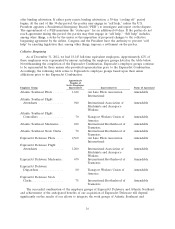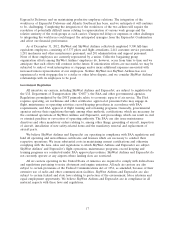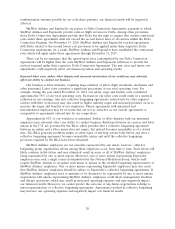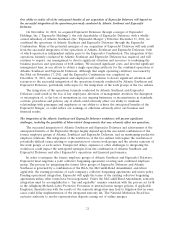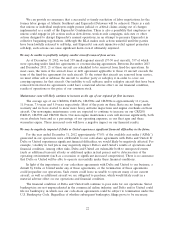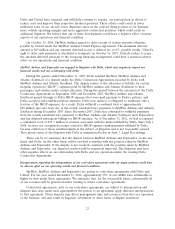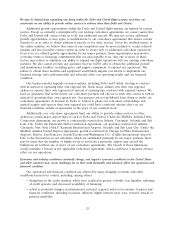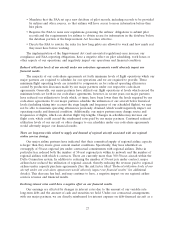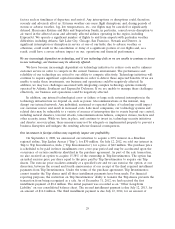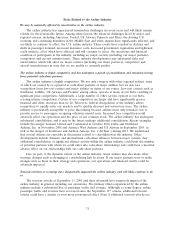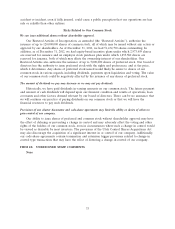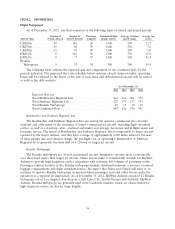SkyWest Airlines 2012 Annual Report Download - page 28
Download and view the complete annual report
Please find page 28 of the 2012 SkyWest Airlines annual report below. You can navigate through the pages in the report by either clicking on the pages listed below, or by using the keyword search tool below to find specific information within the annual report.In recent years we have experienced disagreements with our major partners regarding the
interpretation of various provisions of our code-share agreements. Some of those disagreements have
resulted in litigation (see the preceding risk factor entitled ‘‘SkyWest Airlines and ExpressJet are engaged
in litigation with Delta, which may negatively impact our financial results and our relationship with Delta’’),
and we may be subject to additional disputes and litigation in the future. Those disagreements have
also required a significant amount of management time and financial resources.
To the extent that we continue to experience disagreements regarding the interpretation of our
code-share or other agreements, we will likely expend valuable management time and financial
resources in our efforts to resolve those disagreements. Those disagreements may result in litigation,
arbitration or other proceedings. Furthermore, there can be no assurance that any or all of those
proceedings, if commenced, would be resolved in our favor. An unfavorable result in any such
proceeding could have adverse financial consequences or require us to modify our operations. Such
disagreements and their consequences could have an adverse effect on our operating results and
financial condition.
We have a significant amount of contractual obligations.
As of December 31, 2012, we had a total of approximately $1.6 billion in total long-term debt
obligations. Substantially all of this long-term debt was incurred in connection with the acquisition of
aircraft, engines and related spare parts. We also have significant long-term lease obligations primarily
relating to our aircraft fleet. These leases are classified as operating leases and therefore are not
reflected as liabilities in our consolidated balance sheets. At December 31, 2012, we had 568 aircraft
under lease, with remaining terms ranging from one to 13 years. Future minimum lease payments due
under all long-term operating leases were approximately $2.2 billion at December 31, 2012. At a 4.7%
discount factor, the present value of these lease obligations was equal to approximately $1.8 billion at
December 31, 2012. Our high level of fixed obligations could impact our ability to obtain additional
financing to support additional expansion plans or divert cash flows from operations and expansion
plans to service the fixed obligations.
Our fleet replacement will require a significant increase in our leverage and the related cash outflows.
We currently have 268 CRJ200s with an average life of 11.2 years, 242 ERJ145s with an average
life of 11.0 years and 42 Brasilia turboprops with an average life of 15.4 years. We anticipate that over
the next several years, we will continue to replace these aircraft with large regional jets or turboprops.
Our fleet replacement strategy will require significant amounts of capital to acquire these large regional
jets or turboprops.
There can be no assurance that our operations will generate sufficient cash flow or liquidity to
enable us to obtain the necessary aircraft acquisition financing to replace our current fleet, or to make
required debt service payments related to our existing obligations. Even if we meet all required debt,
lease, and purchase obligations, the size of these long-term obligations could negatively affect our
financial condition, results of operations, and the price of our common stock in many ways, including:
• increasing the cost, or limiting the availability of, additional financing for working capital,
acquisitions or other purposes;
• limiting the ways in which we can use our cash flow, much of which may have to be used to
satisfy debt and lease obligations; and
• adversely affecting our ability to respond to changing business or economic conditions or
continue our growth strategy.
If we need additional capital and cannot obtain such capital on acceptable terms, or at all, we may
be unable to realize our fleet replacement plans or take advantage of unanticipated opportunities
24




